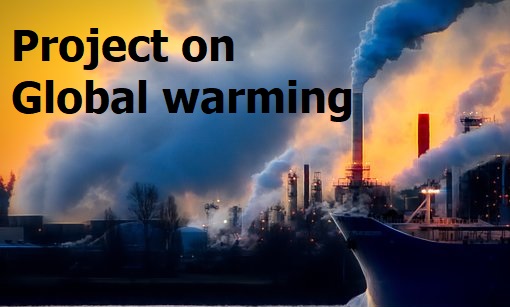Project On Global Warming: How to start?
Project on global warming can be a complex task, but with the right approach, it can be done effectively. To complete a project on global warming, you must be clear about the objective of your project. Stay focused on the main topic. Have a thorough literature review on the subject. Do not forget to include the latest scientific research and policy developments related to global warming. This will give you a strong understanding of the current state of knowledge and help you identify gaps in the literature that your project can address.
Further, it is also important to consider the perspectives of different stakeholders, including scientists, policymakers, industry leaders, and community members. Once you have all the related data and information, you may start writing the project. Finally, complete your project in a clear and concise manner, highlighting the significance of your research and its potential implications for addressing global warming. Global warming is also an important topic of Disaster Management.
Project On Global Warming: How to start?
Table of contents
- Introduction
- Effects Of Global Warming
- Major Factors Responsible For Global Warming
- Impact On Natural Vegetation
- Effect Of Global Warming On Wildlife
- Further Effects Of Global Warming
- Steps To Reduce Global Warming
- UN’S Role In Combating Global Warming
- Conclusion
Introduction
Today, Global warming is one of the most pressing issues our planet is facing.
The Earth’s average surface temperature has risen by about 1.1 degrees Celsius.
Late in the late 19th century, the majority of scientists agree that human activity is responsible for this increase.
The burning of fossil fuels, deforestation, and industrial practices all contribute to the buildup of greenhouse gases in the atmosphere,
which traps heat and causes the planet to warm.
Effects Of Global Warming
The effects of global warming are already being felt around the world.
Rising temperatures are causing more frequent and severe heat waves, droughts, and storms.
Melting ice caps and rising sea levels are threatening coastlines and low-lying areas.
Changes in weather patterns are affecting agriculture and food production.
Moreover, warmer temperatures are leading to the spread of disease and pests.
Some of the effects of Global Warming are mentioned below
Rising temperatures:
Global warming is causing the Earth’s average surface temperature to rise, leading to more frequent and severe heat waves, droughts, and storms.
Melting ice caps and rising sea levels:
The melting of ice caps and glaciers, as well as the thermal expansion of seawater, is causing sea levels to rise and threatening coastlines and low-lying areas.
Changes in weather patterns:
Global warming is leading to changes in weather patterns, which is affecting agriculture and food production.
Spread of disease and pests:
Warmer temperatures can also lead to the spread of disease and pests, which can have a significant impact on human health and the environment.
Loss of biodiversity:
Global warming is causing changes in ecosystems and habitats, which is leading to the loss of biodiversity and the extinction of species
Major Factors Responsible For Global Warming
The burning of fossil fuels
The burning of fossil fuels, such as coal, oil, and natural gas, which releases large amounts of carbon dioxide and other greenhouse gases into the atmosphere, is the primary cause of global warming.
Deforestation
Deforestation and other forms of land-use change, which remove carbon sinks and release stored carbon into the atmosphere, also contribute to global warming.
Industrial processes and agriculture
Industrial processes and agriculture also release greenhouse gases, such as methane and nitrous oxide, into the atmosphere.
Use of certain chemicals
The use of certain chemicals, such as hydrofluorocarbons (HFCs), used in refrigeration and air conditioning, also contributes to global warming
Population growth and economic development
Human population growth and economic development have led to an increase in energy consumption and emissions, further driving global warming
Impact On Natural Vegetation
- Firstly, changes in temperature and precipitation patterns can alter the distribution and growth of tree species, leading to changes in the structure and composition of forest ecosystems.
- Secondly, the Increased frequency and severity of wildfires, droughts, and storms can damage or destroy large areas of forest.
- Thirdly, rising temperatures can lead to increased water stress, pests, and diseases, which can weaken or kill trees, leading to forest decline.
- Fourthly, changes in the timing of seasons, such as earlier spring arrival, can disrupt the synchrony between the life cycles of trees and their pollinators and seed dispersers.
- Finally, rising sea levels and increased coastal flooding can damage or destroy mangroves and coastal forests, which provide important ecosystem services such as coastal protection, carbon sequestration, and habitat for biodiversity.
Effect Of Global Warming On Wildlife
Firstly, Global warming can have a wide range of negative effects on wildlife.
This is because rising temperatures alter the timing of seasons.
Therefore, it disrupts the synchrony between the life cycles of animals and their food sources, leading to declines in population.
Moreover, changes in precipitation patterns can affect the availability of water for wildlife.
In turn, it will also affect the growth of vegetation on which they depend.
Warmer temperatures can also increase the range and severity of diseases, pests, and invasive species, which can harm wildlife populations.
Many species of animals are also highly sensitive to changes in temperature and are likely to be affected by global warming.
For example, many species of fish and amphibians are intolerant to changes in water temperature, which can lead to declines in population.
Many species of birds, butterflies, and other insects are also highly sensitive to temperature changes.
All these factors can alter the timing of their migration and breeding patterns, leading to declining in population.
Further Effects Of Global Warming
- The effects of global warming can also interact with other human activities, such as habitat destruction, pollution, and over-harvesting, which can exacerbate the negative effects on wildlife populations.
- In addition, many species that are adapted to live in specific conditions (e.g. polar bears, arctic foxes, penguins) are facing severe challenges as their habitats are disappearing or becoming inhospitable.
- Climate change also makes it harder for wildlife populations to adapt to new conditions and for conservation efforts to be effective.
Steps To Reduce Global Warming
reducing our greenhouse gas emissions
One of the most important things we can do to slow the pace of global warming is to reduce our greenhouse gas emissions.
This means reducing our reliance on fossil fuels and investing in renewable energy sources like wind and solar power.
It also means making changes in our daily lives, such as using energy-efficient appliances, driving less, and eating a more plant-based diet.
Using Renewable energy sources
Reduce carbon emissions by transitioning to renewable energy sources such as solar, wind, and hydropower.
By Increasing energy efficiency
By increasing energy efficiency through measures such as insulation, efficient appliances, and smart grid technology we can reduce the impact of Greenhouses.
Implementing carbon pricing mechanisms
By Implementing carbon pricing mechanisms, such as a carbon tax or cap-and-trade system, one can financially incentivize reducing emissions.
Using Public Transport
Promote sustainable transportation by investing in public transportation, biking, and walking.
Sustainable land use practices
By Encouraging sustainable land use practices, such as reforestation, conservation, and sustainable agriculture.
This can further sequester carbon and reduce emissions from land use change.
Protect and restore our natural ecosystems
Another important step is to protect and restore our natural ecosystems.
such as forests and wetlands, help to absorb and store carbon dioxide.
This can be done through conservation efforts and reforestation projects.
Raise awareness about global warming
It’s also important to raise awareness about global warming and the steps we can take to slow it down.
This includes educating ourselves and others about the issue.
Supporting politicians and policies that address global warming, and taking personal actions to reduce our carbon footprint.
UN’S Role In Combating Global Warming
Firstly The United Nations Framework Convention on Climate Change (UNFCCC) is the main international treaty on climate change.
It coordinates the global response to climate change through this treaty.
Secondly, the UNFCCC hosts the annual Conference of the Parties (COP) where countries come together to negotiate and implement the Paris Agreement.
which aims to limit global warming to well below 2 degrees Celsius and pursue efforts to limit it to 1.5 degrees Celsius.
Thirdly, the UN also provides technical and financial assistance to countries.
Fourthly, the UN also works to raise public awareness and educate people about the impacts of climate change and the actions that can be taken to combat it.
Lastly, the UN also engages with the private sector and civil society to mobilize resources.
It also builds partnerships to tackle climate change and promote sustainable development.
Conclusion
In conclusion, global warming is a serious threat to our planet, but it’s not too late to take action.
By reducing our greenhouse gas emissions, protecting and restoring natural ecosystems, and raising awareness about the issue.
we can slow the pace of global warming and help to ensure a sustainable future for ourselves and future generations.





0 Comments